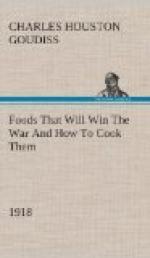Dr. Harvey W. Wiley has stated that the meat eating of the future will not be regarded as a necessity so much as it has been in the past, and that meat will be used more as a condimental substance. Europe has for years used meat for flavor rather than for nutriment. It would seem that the time has come for Americans to learn the use of meat for flavor and to utilize more skillfully the protein of other foods.
It may be difficult to convince the meat lover that he can radically reduce the proportion of meat in his diet without detriment to health. Many persons adhere to the notion that you are not nourished unless you eat meat; that meat foods are absolutely necessary to maintain the body strength. This idea is entirely without foundation, for the foods mentioned as meat substitutes earlier in this chapter can be made to feed the world, and feed it well—in fact, no nation uses so large a proportion of meat as America.
The first step, therefore, in preparing ourselves to reduce meat consumption is to recognize that only a small quantity of meat is necessary to supply sufficient protein for adult life. The growing child or the youth springing into manhood needs a larger percentage of meat than the adult, and in apportioning the family’s meat ration this fact should not be overlooked.
The second step is to reduce the amount purchased, choosing cuts that contain the least waste, and by utilizing with care that which we do purchase. Fat, trimmings, and bones all have their uses and should be saved from the garbage pail.
Careful buying, of course, depends on a knowledge of cuts, a study of the percentage of waste in each cut, and the food value of the different kinds of meat. Make a study of the different cuts, as shown in the charts on pages 36, 37, and armed with this knowledge go forth to the butcher for practical buying.
Then comes the cooking, which can only be properly done when the fundamental principles of the cooking processes, such as boiling, braising, broiling, stewing, roasting and frying are understood. Each cut requires different handling to secure the maximum amount of nutriment and flavor. The waste occasioned by improper cooking is a large factor in both household and national economy.
It has been estimated that a waste of an ounce each day of edible meat or fat in the twenty million American homes amounts to 456,000,000 pounds of valuable animal food a year. At average dressed weights, this amounts to 875,000 steers, or over 3,000,000 hogs. Each housekeeper, therefore, who saves her ounce a day aids in this enormous saving, which will mean so much in the feeding of our men on the fighting line.
So the housekeeper who goes to her task of training the family palate to accept meat substitutes and meat economy dishes, who revolutionizes her methods of cooking so as to utilize even “the pig’s squeak,” will be doing her bit toward making the world safe for democracy.




